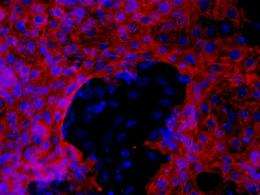Scientists map the genomic blueprint of the heart

Scientists at the Gladstone Institutes have revealed the precise order and timing of hundreds of genetic "switches" required to construct a fully functional heart from embryonic heart cells—providing new clues into the genetic basis for some forms of congenital heart disease.
In a study being published online today in the journal Cell, researchers in the laboratory of Gladstone Senior Investigator Benoit Bruneau, PhD, employed stem cell technology, next-generation DNA sequencing and computing tools to piece together the instruction manual, or "genomic blueprint" for how a heart becomes a heart. These findings offer renewed hope for combating life-threatening heart defects such as arrhythmias (irregular heart beat) and ventricular septal defects ("holes in the heart").
"Congenital heart defects are the most common type of birth defects—affecting more than 35,000 newborn babies in the United States each year," said Dr. Bruneau, who is the associate director of cardiovascular research at Gladstone, an independent and nonprofit biomedical-research organization. "But how these defects develop at the genetic level has been difficult to pinpoint because research has focused on a small set of genes. Here, we approach heart formation with a wide-angle lens by looking at the entirety of the genetic material that gives heart cells their unique identity."
"Congenital heart defects are the most common type of birth defects—affecting more than 35,000 newborn babies in the United States each year," said Dr. Bruneau, who is the associate director of cardiovascular research at Gladstone, an independent and nonprofit biomedical-research organization. "But how these defects develop at the genetic level has been difficult to pinpoint because research has focused on a small set of genes. Here, we approach heart formation with a wide-angle lens by looking at the entirety of the genetic material that gives heart cells their unique identity."
In this research—conducted in large part at Gladstone's Roddenberry Center for Stem Cell Biology and Medicine, as well as in collaboration with the laboratory of Laurie Boyer, PhD, at the Massachusetts Institute of Technology—the scientists took embryonic stem cells from mice and reprogrammed them into beating heart cells by mimicking embryonic development in a petri dish. Next, they extracted the DNA from developing and mature heart cells, using an advanced gene-sequencing technique called ChIP-seq that lets scientists "see" the epigenetic signatures written in the DNA.
"But simply finding these signatures was only half the battle—we next had to decipher which aspects of heart formation they encoded," said Jeffrey Alexander, a Gladstone and UCSF graduate student and one of the paper's lead authors. "To do that, we harnessed the computing power of the Gladstone Bioinformatics Core. This allowed us to take the mountains of data collected from gene sequencing and organize it into a readable, meaningful blueprint for how a heart becomes a heart."
The team made some unexpected discoveries. They found that groups of genes appear to work together in heart cells in a coordinated fashion—switching on and off as a group at designated times during embryonic development. The scientists not only identified a whole host of new genes involved in heart formation, but they also refined exactly how these newly discovered genes interact with previously known genes.
The human-health implications of mapping the genomic blueprint of the heart are far reaching. Now that scientists understand how these genes control the heart, they can begin to piece together how heart disease disrupts this regulation. Eventually, they can look for therapies to prevent, interrupt or counteract those disruptions in children who suffer from congenital heart disease.
"Our findings reveal new clues as to how complex genetic and epigenetic patterns are precisely regulated during heart formation," said Dr. Boyer. "In particular, our identification of key segments of the genome that contribute to this process will hopefully allow us to identify the genetic causes of many forms of congenital heart disease—an important first step in the fight against this devastating disease."
"Next, we hope to examine the DNA of patients living with congenital heart disease, in the hopes that we can pinpoint the specific genetic disruption that caused their heart defect," said Dr. Bruneau, who is also a professor of pediatrics at the University of California, San Francisco, with which Gladstone is affiliated. "Once we identify that disruption, we can begin exploring ways to restore normal gene function during early heart formation—and reduce the number of babies born with debilitating, and sometimes fatal, congenital heart defects."
















